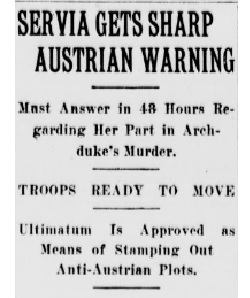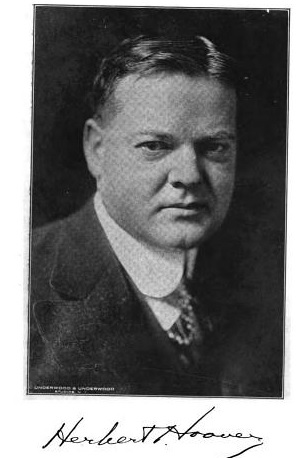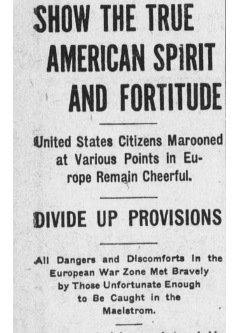As seen on the front page of the Harrisburg Telegraph of July 31, 1914, war in Europe is now certain. Russia is putting its army on a war footing, and in both Berlin and London, war is believed to be inevitable.

As seen on the front page of the Harrisburg Telegraph of July 31, 1914, war in Europe is now certain. Russia is putting its army on a war footing, and in both Berlin and London, war is believed to be inevitable.
A hundred years ago today, July 30, 1914, Germany, Russia, and the other powers had yet to join the war, and there was some hope that they would not. But as this front-page cartoon in the Harrisburg Telegraph makes clear, that hope was quickly fading.
This 1921 photo shows U.S. Forest Service radio operator F.K. Teeter, Jr., at his post monitoring for forest fires. The Forest Service had aircraft equipped with a 1.8 kw spark transmitter, with a trailing wire with a lead weight at the end. The entire transmitter was encased in a torpedo-shaped shell mounted on the running gear. Only the key and ammeter were inside the plane. The aircraft was not equipped with a receiver, and the ground stations were not equipped with a transmitter. Instead, the aircraft transmitted in the blind, using a code indicating the type of fire and location by township, section, and range.
The system was reported to give very satisfactory results.
Read More at Amazon:
According to Wikipedia, and most other sources, World War 1 began a hundred years ago today, July 28, 1914. But as I showed two days ago, the Washington afternoon newspaper for July 26 reports that Austria declared war on Serbia on that day.
This illustration from the August 1923 issue of Wireless Age shows Joan Jarvis listening to a portable receiver in her canoe. The accompanying article points out that the phonograph record industry should not be alarmed by Miss Jarvis’ entertainment options, since she is likely to purchase phonograph records of the songs she hears over the radio.
If you wanted a portable radio 75 years ago, you could have one. It would weigh a mere 14 pounds, and would only set you back a dollar a week. This set was available for $19.95, or one dollar a week. It is shown here in this ad from the Milwaukee Sentinel for July 27, 1939.
I haven’t been able to find any information on the particular portable in the ad, but it looks very similar to the RCA model shown here. The RCA weighed in at 14 pounds, had four tubes, and operated on a 1.4 volt A battery and 90 volt B battery. The B battery was stated to last 250 hours, and sold for $3.50.
On June 26, 1914, Europe was at war. With its ultimatum not heeded to its satisfaction, Austria declared war on Serbia and its army began marching on Belgrade. The Serbian capital, which the government had deemed indefensible, had been evacuated. King Peter of Serbia had instead shifted the seat of government 60 miles to the south to the mountain town of Kraguyevats. Within days, Russia, Germany, Britain, and France would join the war.
 A hundred years ago, the front page of the New York Sun of July 24, 1914 reported that the Panama Canal was scheduled to open on August 15 to vessels drawing less than thirty feet. It reported that the Canadian government’s upgrades to the Cape Race wireless station would double its range to 500 miles, making it the first point of communication with ships sailing to North America.
A hundred years ago, the front page of the New York Sun of July 24, 1914 reported that the Panama Canal was scheduled to open on August 15 to vessels drawing less than thirty feet. It reported that the Canadian government’s upgrades to the Cape Race wireless station would double its range to 500 miles, making it the first point of communication with ships sailing to North America.
And it also reported the Austrian government’s July 23 ultimatum to Serbia (then usually spelled Servia) in the wake of the assassination of Archduke Franz Ferdinand. Another report in the same paper states that Germany and Italy support the Austro-Hungarian action, and that many believed that war was inevitable.
Europe was now days away from war.

Samuel J. Woolf, First Aid Station at Seicheprey, oil, 1919 at Google Books
75 years ago, the 1939 Allied Radio catalog carried these two kits. The “One Tube Flashlight Set” sold for $4.45, and included everything (tube, batteries, and coils) with the exception of the headphones, which started in the same catalog for 66 cents. The “Hurricane Receiver” sold for $3.85, but in addition to the headphones, also required a 6J7 and a 6F6 tube, which sold for 77 cents each.
Both sets ran on 6 volts. The one-tube “flashlight” set tuned shortwave, 18 to 200 meters, with four plug-in coils.
Both of these sets are regenerative receivers, and originated as construction articles in Popular Mechanics. The “Flashlight” set originated in the April 1938 issue, where it was billed as a “one-tube DX short-wave set” that ran on flashlight batteries, hence the name.
The “hurricane set” was featured in the February 1937 issue, which stated:
The primary idea behind the design is to provide a simple, rugged portable receiver that will work from a 6-volt storage battery, or a few dry cells, when other sources of power fail. When floods, hurricanes or other natural catastrophes occur and all ordinary means of communication go out, it is satisfying, and sometimes vitally important, to be able to learn from outside radio stations just what is going on. As a portable knockabout set, it also has other useful applications in the home, boat or camp.
The article promises that with six volts, the hurricane set with a 25-foot antenna should be sufficient for satisfactory reception of medium or high-power stations within a range of about 500 miles.
Parts List for “Flashlight Set”
If you are interested in building a one-tube radio, the “flashlight set” would be a good starter, and you can use the Popular Mechanics article for all of the construction details. Some of the parts might be difficult to find. But all of them are available online. Some of the links below are rather expensive, so it’s best to find most of the parts locally. But if you’re missing one or two items, you can find them at the links below.
Some of the values shown here are not identical to those shown in the article, but all of them are close enough. The only effect of substituting parts is that the tuning range of the radio will vary, depending on the exact dimensions of the coil, and the value of the tuning capacitor. Therefore, you’ll have to experiment a bit to figure out the exact tuning range of the radio once it’s done.

Herbert Hoover in about 1920. Google Books.
A hundred years ago, the forces of war were relentlessly at work in Europe, but few other than heads of state and diplomats knew that the continent was about to erupt into conflict. Tens of thousands of Americans were in Europe, and the outbreak of hostilities caught them by surprise.
 This article from the Liberal (Kansas) Democrat of August 14, 1914, reports the plight of those Americans who found themselves in Europe. Most found themselves stranded, food was scarce, and a great number of them found themselves penniless. One woman with two children, for example, was reported to be stranded in Prussia without cash but holding $2500 in checks.
This article from the Liberal (Kansas) Democrat of August 14, 1914, reports the plight of those Americans who found themselves in Europe. Most found themselves stranded, food was scarce, and a great number of them found themselves penniless. One woman with two children, for example, was reported to be stranded in Prussia without cash but holding $2500 in checks.
The self-made millionaire mining engineer Herbert Hoover would later relate that this was the time that he ceased to be a private citizen. He became renowned for his relief efforts for Belgium, and later for the rest of Europe. And he began by assisting stranded Americans in London. The paper reports:
Herbert C. Hoover, a Californian, opened an office today in the American consulate and advanced amounts of $25 and upward to persons unable to get money by other means. Altogether Mr. Hoover gave assistance to 300 Americans who were absolutely without cash and announced that he would continue to aid them as long as his currency lasted.
As author Vernon Kellog later described this venture:
He gathered together all his available money and that of American friends and opened a unique bank which had no depositors and took in no money, but continuously gave it out against personal checks signed by unknown but American-looking people on unknown banks in Walla Walla and Fresno and Grand Rapids and Dubuque and Emporia and New Bedford. And he found rooms in hotels and passage on steamers, first-class, second-class or steerage, as happened to be possible. Now on all these checks and promises to pay, just $250 failed to be realized by the man who took a risk on American honesty to the extent of several hundred thousand dollars.
Read More at Amazon: